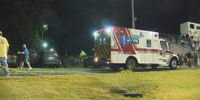Two separate shootings at American high schools this week have reignited urgent conversations about campus safety, the effectiveness of security measures, and the growing toll of gun violence on students and communities. In Colorado and North Carolina, young lives were upended in moments of terror, leaving families, officials, and educators grappling with the aftermath and searching for answers.
On Wednesday, September 10, chaos erupted at Evergreen High School in Evergreen, Colorado, a quiet town about 30 miles southwest of Denver. According to the Jefferson County Sheriff’s Office, 16-year-old Desmond Holly opened fire on campus, wounding two students before dying from a self-inflicted gunshot wound. The incident sent shockwaves through the local community and drew national attention as details emerged about the shooter’s actions and motives.
Authorities identified one of the wounded students as 18-year-old Matthew Silverstone. In a statement shared by the sheriff’s office, Silverstone’s family expressed gratitude for the outpouring of support, adding, "The family appreciates the community’s concern and support, but as we remain focused on our loved one’s recovery, we respectfully request privacy as we continue to heal and navigate the road ahead." The second victim’s identity has not been released at the family’s request.
Medical officials reported that one victim remains in critical condition at St. Anthony’s Hospital, while the other, whose injuries are not life-threatening, was transferred to Children’s Hospital Colorado in Aurora, as reported by KUSA. The physical wounds are only part of the story, as the psychological impact on students, staff, and families is likely to linger long after the headlines fade.
The sheriff’s office offered a chilling account of the attack, revealing that Holly arrived at school by bus carrying a revolver and a substantial amount of ammunition. Jacki Kelley, public information officer for the Jefferson County Sheriff’s Office, told Denver7, "The suspect’s gun was fired a lot. The reason we have so many crime scenes is because we have windows that were shot up, we have lockers that were shot up. We have spent rounds, unspent rounds. It’s a huge area." In the aftermath, investigators found evidence of gunfire both inside and outside the school, with one victim shot indoors and the other outside, according to the New York Times.
Law enforcement responded in force, with more than 100 officers converging on Evergreen High School as reports of the shooting spread. The rapid and coordinated response likely prevented further casualties, but the sense of vulnerability remains palpable. Colorado Governor Jared Polis addressed the tragedy in a public statement, writing, "My heart is with the students, families, and entire Evergreen community after today’s tragic shooting. No young person should have to carry this kind of trauma, and help is available."
Officials revealed that Holly had been "radicalized by some extremist network," a detail that adds another layer of complexity and concern to the unfolding investigation. The specifics of the radicalization and how it may have influenced the attack remain under scrutiny, but the revelation highlights the broader challenges schools face in identifying and intervening with at-risk youth before violence occurs.
Just two days later, on the evening of September 12, another school shooting occurred—this time at a high school football game in Edgecombe County, North Carolina. As reported by WITN and WRAL, the incident took place during a matchup between Tarboro and Southwest Edgecombe high schools. With less than two minutes left in the third quarter, gunfire rang out, prompting an immediate evacuation of the stadium.
The Edgecombe County Sheriff’s Office confirmed that two teens—a 17-year-old boy and a 16-year-old girl—were injured in the shooting. Both victims are in stable condition, and medical professionals are optimistic about their recovery. The sheriff’s office praised the quick actions of deputies, first responders, school officials, players, and fans, stating, "Sheriff’s deputies, first-responders, school officials, players, and fans acted decisively and appropriately to keep this situation from becoming worse."
What makes the North Carolina shooting especially troubling is that it occurred despite significant security measures. The sheriff’s office noted that the stadium had weapons detection systems, metal detectors at the gate, and a strong law enforcement presence. Nevertheless, someone managed to bring a weapon into the event, raising difficult questions about the limits of current security protocols and the ingenuity of those intent on causing harm.
In the wake of the shooting, Edgecombe County Public Schools and the sheriff’s office have launched a review of safety and security procedures. Their joint statement underscores the widespread anxiety over increasing violence: "We’re facing a terrible situation right now with so much violence all across our state and across the nation. We’re certainly not happy this has reached our community, and we all need to work together to stop this for the sake of us all—our families and neighbors. We have faith that we can."
These two incidents, separated by geography but united by tragedy, highlight the persistent challenge of gun violence in American schools. Despite years of debate, policy proposals, and technological upgrades, firearms continue to find their way onto campuses and into the hands of young people. The fact that the North Carolina shooting happened in the presence of metal detectors and police, and the Colorado attack involved a student radicalized online, points to the evolving and multifaceted nature of the threat.
For families and educators, the emotional toll is profound. The Silverstone family’s plea for privacy is echoed in communities nationwide, where the fear of "what if" shadows daily routines. Students who witness or survive such violence often face long-term psychological effects, including anxiety, depression, and post-traumatic stress. The need for accessible mental health support is more urgent than ever, as echoed by Governor Polis’s call for help and healing.
Law enforcement agencies and school districts are left to balance the need for increased security with the desire to maintain a welcoming, supportive educational environment. Some advocate for more robust mental health resources and early intervention programs, while others push for stricter gun control laws and enhanced security technology. The debate is heated, and consensus remains elusive, but the stakes could not be higher.
As the investigations continue in both Colorado and North Carolina, communities are left to pick up the pieces and chart a path forward. The resilience of students, families, and first responders is evident in their immediate actions and ongoing efforts to support one another. Yet, the underlying issues—access to firearms, youth radicalization, and the limitations of security measures—demand sustained attention and collective action.
For now, the names of the victims and the details of the shootings serve as stark reminders of the work that remains. Whether in the halls of Evergreen High School or the stands of a Friday night football game, the question persists: what more can be done to keep America’s children safe?





